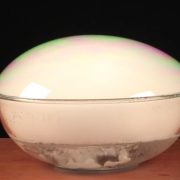Cup Cakes For Science
Preparation for standardized testing has taken a lot of the fun out of the classroom, but good teachers will find a way to sneak the fun back in. REALLY good teachers will sneak the fun back in and teach some awesome lessons at the same time!
Science teachers frequently say, “I love all the activities you do, like being able to make slime, or make water float in a bottle, but of the 220 activities you taught us, only a handful were allowed in my school curriculum. There just isn’t enough time for science because it’s not on the big test!”
A colleague went to her principal and asked: “If it is not in school time, but in private time, do you mind if I teach science?”? The principal agreed.
On average, an elementary teacher spends about 15 minutes per child per year on his/her birthday, and each year that time grows shorter. That’s why “Cup Cakes for Science” was born. The kids were offered a choice between a traditional party or a science party where the birthday child gets to be helper. After one party, the class was hooked, and they even asked for science parties for their brothers and sisters too.
Children are starving for science. It is sad when a teacher has to find sneaky ways to put science back in the curriculum, but if it means trading cup cakes for science, then that is what a teacher has to do. This teacher with 23 children was able to provide those children with 23 additional learning experiences they have never had before and those experiences were unforgettable.
Plus, the Birthday Boy/Girl got to do all the really awesome stuff! And there were still cup cakes!






I have a son who was never assigned a science project. The reasons have nothing to do with tests (which makes me more than a bit skeptical when I hear that excuse). The excuse given, since he was always in a special education resource room, was that they were going to focus first on reading and math–and he could get those other things later. After all, science and social studies are really just about reading (and people seem to believe this!) Now, between you, me and the lamppost, I think if he, and his classmates had been focused meaningfully on mathematics and reading that whole time, things might look a bit different now.
When he was in middle school–and stuck in a broadly graded mini-classroom with a teacher and an aide pushing worksheets all day long (none of which were particularly aligned to the tested curriculum), I did spend some time searching the web for some solid, aligned, engaging and hands-on lessons as examples of what might be done. I found this really wonderful piece on embalming a chicken (it involved salt and plastic bags and draining–it sounded like the kind of thing those weird middle school minds would really freak out about). It would really have fit into what the social studies curriculum required–which had to do trade and culure in early Egypt. If I ran the world, those kids would have been wrapping that chicken up in gauze and decorating it with symbols and looking up on the internet to see where the materials came from and measuring the salt that was required and the weight of the water that drained out. We could have spend hours doing things that absolutely aligned with every part of the curriculum. And I really believe there might have been some stuff that “stuck” when they were taking the tests.
I don’t run the world–and that class never moved away from the worksheets. And it turns out that my son was the only kid from his grade level in there, so the rest were supposed to be aligned to other benchmarks and standards. So on they went with the worksheets.
But it wasn’t the tests.
For the link on Chicken Embalming, go to http://www.dampier.wa.edu.au/Room13/cluck.htm
This is a great experiment and lots of fun to do.
I enjoyed this website but i would like to see some more exploding stuff. Thank you keep the good work Steve Spangler.